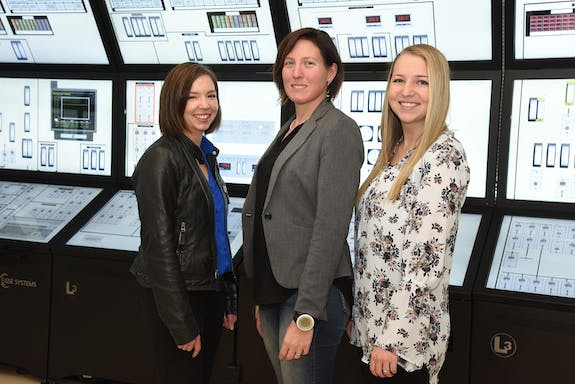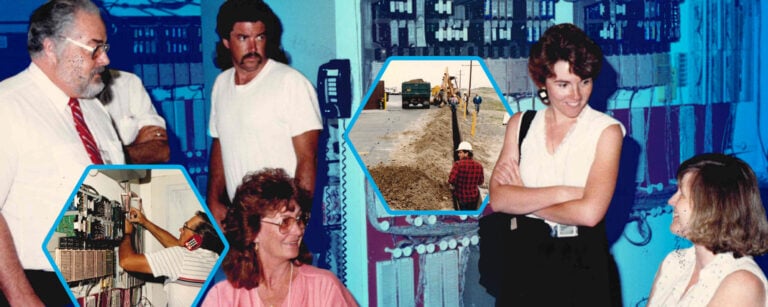Right now, all over the world, a generation is growing up with some of the most complicated technologies at their fingertips from birth. The world of smartphones, tablets and touch screens has opened its doors to people of all ages and most occupations. Workplaces are rapidly watching their paper procedures drift away on the wind, replaced by more dynamic, technologically governed processes.
As many industries embrace the latest technologies, the nuclear industry has kept a firm grip on both paper and manual procedures. However, as the winds of change blow across the horizon and nuclear races to keep up with other contemporary energy sources, the industry has begun to consider adopting technology that would help streamline its procedures and make reactor operation more efficient.
One such technology is called Electronic Instructions for Nuclear Applications, or ELINA. In 2012, Johanna Oxstrand and Dr. Katya LeBlanc of INL’s Human Factors team began working on computer-based procedures for nuclear fieldworkers, who conduct all the work in a nuclear reactor outside the main control room. The research was conducted under the Light Water Reactor Sustainability (LWRS) program.
“What we wanted to do is find out how we can take all the information that is in the paper procedures and instructions and present that to field workers in a way that makes sense,” Oxstrand explained. “There were already products on the market that put paper procedures onto tablets as PDFs … but we weren’t entirely sold on this. We wanted to do something more with the procedures.”
Oxstrand and LeBlanc began with research on how procedures were currently being used, what worked well and what could be improved. “Back at this time, we didn’t know much about how procedures were used,” Oxstrand said. “But we learned a lot through observing and interviewing workers, and we defined requirements for what we thought computer-based procedures should be. Based on those, we developed our first prototype.” They then tested this prototype, with the goal of discovering whether it was easier for fieldworkers to perform their tasks using standard paper procedures, or their computer-based design.
“Our very first design turned out to be quite terrible,” Oxstrand lamented. “We learned through our research that fieldworkers wanted to be able to focus on the task at hand, and not be overwhelmed by everything else. So we thought it would be a great idea to only show them one step of the procedures at a time. And they hated it. It gave them tunnel vision, and they lost sight of the overall task. But with all we knew from a theoretical background, that should have been a good design.”
This issue highlights one of the major challenges with the project, as addressed by LeBlanc. The ELINA team learned that there was a big difference between designing something that works ideally from a research perspective, and actually being able to commercialize that technology.
Fortunately, the Energy I-Corps program stepped in to aid the ELINA team with the business and marketing aspect of their technology. As Mark Kaczor, I-Corps instruction program coordinator, explained, “The goal of the Energy I-Corps program is to get our researchers to truly understand what it is the market wants from the technology they’re developing.”
“The marketplace rarely wants what you have; they want some variant of it,” Kaczor said. “The only way to find out what that variant is, is to meet with people who are interested in your idea and find out what they really need.”
Ultimately, the ELINA team, which expanded to include researcher Rachael Hill, started over four or five times before they reached a prototype that was successful. The team collaborated with as many utilities who might use the ELINA technology as they possibly could, since all utilities conduct procedures differently. They conducted laboratory control studies and field tests where, according to Oxstrand, they “took one or more of the fieldworkers’ existing procedures, converted them into the ELINA system, and put them on tablets, which then were used by the fieldworkers for a couple of months.”

The team worked closely with their product’s end users in the nuclear industry during these tests, and ultimately came up with a workable design. A part of this was to define functional requirements for Smart Documents, which was conducted through the Nuclear Electronic Work Packages Enterprise Requirements (NEWPER) initiative in 2015 and 2016. Smart documents are anything from basic PDFs with embedded hyperlinks to fully dynamic instructions that allow users to interact with their procedures. These instructions allow workers to answer questions, record values and move on to the next applicable step, without having to consult piles of different paperwork.
NEWPER, which was facilitated by INL, also helped standardize the taxonomy that would be used for Electronic Work Management (EWM). According to Oxstrand, this will “streamline the review process electronically. There’s a lot of carrying papers from desk to desk and getting signatures. The EWM provides infrastructure for how to route documents to different people for review and approval.”
But what is ELINA, specifically?
“ELINA is dependent on having that EWM framework,” Oxstrand explained. “ELINA plugs in and replaces those not-so-smart Smart Documents, like basic PDFs, with dynamic and interactive instructions.”
The ELINA team acquired two DOE Technology Commercialization Fund (TCF) awards to mature their idea and develop it with an industry partner. The first TCF, for $150,000, helped them revise and copyright the ELINA code. The second TCF allows them to partner with an outside vendor, NextAxiom Inc., to develop the technology. The combined funding from NextAxiom Inc. and the Department of Energy provides an overall $1.5 million in funding for the eventual commercialization of ELINA.
Art Baker, a commercialization manager with Technology Deployment, worked with the ELINA team and Kaczor on these TCFs and the Cooperative Research and Development Agreement (CRADA) for the project. Baker believes that ELINA has strong potential for success.
“It has the potential to really streamline the technologies,” he explained. “It showed work toward reducing the actual operating costs of the plants, so they’re competitive with gas and coal and other forms of power generation. It should also reduce the chances of mistakes being made.”
Kaczor added that “ELINA should also reduce personnel costs. One person should be able to get more done with less hands-on verification required.”
The ELINA team is also excited about the technology’s potential to save the industry big bucks. “ELINA means that the operators are spending more time doing work, rather than managing procedures, and that in turn saves the utility money,” LeBlanc explained. “Nuclear’s biggest barrier to success is that it can’t operate economically.”
During their work on this project, the ELINA team saw a dramatic shift in how people perceived their technology. Initially, LeBlanc explained, they “got a lot of resistance from just about everyone. They were saying, ‘this is never going to happen; this is a pipe dream. It’s so different from the way we do things.’ But each time we brought a new prototype out, we got a little less resistance.”
It was difficult for the team to convince workers initially to want to change their procedures. But as LeBlanc said, “We weren’t changing the intent of the procedures, but we were changing the way they were presented.”
After discovering a successful prototype, the team faced an entirely different challenge. People began asking about and wanting access to the ELINA technology, even though it was not available. “Going from everyone saying ‘this is never going to happen,’ to everyone saying ‘this needs to happen now,’ is pretty exciting,” LeBlanc said.
During this attitude shift, the ELINA team credits the I-Corps program with helping them become more business-savvy. As Hill said, “I-Corps granted me a whole new perspective on research – the business perspective. It’s the realization that your research has an impact.”
LeBlanc was well served by the reminder of her research’s impact as she went through I-Corps, as well. As Kaczor stated, “Technology like ELINA generates outside interest in what our Human Factors team does.” Oxstrand, LeBlanc and Hill all expressed the general sentiment that much of the time, their research is featured in writings and discussed within INL, but it is exciting to see their work’s potential applications in the outside world, both in the nuclear industry and beyond.
Through gaining a full understanding of the business angle of their project and their end users’ desires, the team realized ELINA’s potential impact to help nuclear grow as a power source and provide the world with more clean energy. As LeBlanc stated, “If you want to save the world, you have to care about money.”
Initially, even after their graduation from the I-Corps program, the ELINA team was unsure how the nuclear industry would feel about expanding their technological horizons and embracing more dynamic procedures. However, the team realized that most people, both young and old, are excited about ELINA. As LeBlanc said, “If you think about how much is streamlined for us in our daily lives, it seems absurd to walk into a nuclear power plant and be using manual and paper procedures. People are expecting these changes now, not just the young people. Making it happen will mean people of all ages are more likely to want to work at a nuclear plant.”






